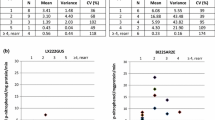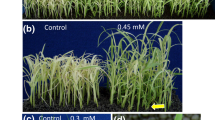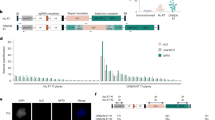Abstract
Key message
Transient 5-azacytidine treatment of leaf explants from potato plants with transcriptionally silenced transgenes allows de novo regeneration of plants with restored transgene expression at the whole plant level.
Abstract
Transgenes introduced into plant genomes frequently become silenced either at the transcriptional or the posttranscriptional level. Transcriptional silencing is usually associated with DNA methylation in the promoter region. Treatments with inhibitors of maintenance DNA methylation were previously shown to allow reactivation of transcriptionally silenced transgenes in single cells or tissues, but not at the whole plant level. Here we analyzed the effect of DNA methylation inhibitor 5-azacytidine (AzaC) on the expression of two silenced reporter genes encoding green fluorescent protein (GFP) and neomycin phosphotransferase (NPTII) in potato plants. Whereas no obvious reactivation was observed in AzaC-treated stem cuttings, transient treatment of leaf segments with 10 μM AzaC and subsequent de novo regeneration of shoots on the selective medium with kanamycin resulted in the production of whole plants with clearly reactivated expression of previously silenced transgenes. Reactivation of nptII expression was accompanied by a decrease in cytosine methylation in the promoter region of the gene. Using the plants with reactivated GFP expression, we found that re-silencing of this transgene can be accidentally triggered by de novo regeneration. Thus, testing the incidence of transgene silencing during de novo regeneration could be a suitable procedure for negative selection of transgenic lines (insertion events) which have an inclination to be silenced. Based on our analysis of non-specific inhibitory effects of AzaC on growth of potato shoots in vitro, we estimated that AzaC half-life in the culture media is approximately 2 days.





Similar content being viewed by others
Abbreviations
- AzaC:
-
5-Azacytidine
- GFP:
-
Green fluorescent protein
- NPTII:
-
Neomycin phosphotransferase
- PTGS and TGS:
-
(Post)transcriptional gene silencing
References
Arase S, Kasai M, Kanazawa A (2012) In planta assays involving epigenetically silenced genes reveal inhibition of cytosine methylation by genistein. Plant Methods 8:10. doi:10.1186/1746-4811-8-10
Aufsatz W, Mette MF, van der Winden J et al (2002) RNA-directed DNA methylation in Arabidopsis. Proc Natl Acad Sci USA 99(Suppl 4):16499–16506. doi:10.1073/pnas.162371499
Baubec T, Pecinka A, Rozhon W, Mittelsten Scheid O (2009) Effective, homogeneous and transient interference with cytosine methylation in plant genomic DNA by zebularine. Plant J 57:542–554. doi:10.1111/j.1365-313X.2008.03699.x
Beisler JA (1978) Isolation, characterization and properties of a labile hydrolysis product of the antitumour nucleoside, 5-azacytidine. J Med Chem 21:204–208. doi:10.1021/jm00200a012
Bernstein E, Caudy AA, Hammond SM, Hannon GJ (2001) Role for a bidentate ribonuclease in the initiation step of RNA interference. Nature 409:363–366. doi:10.1038/35053110
Bolte S, Brown S, Satiat-Jeunemaitre B (2004) The N-myristoylated Rab-GTPase m-Rabmc is involved in post-Golgi trafficking events to the lytic vacuole in plant cells. J Cell Sci 117:943–954. doi:10.1242/jcs.00920
Calarco JP, Borges F, Donoghue MTA et al (2012) Reprogramming of DNA methylation in pollen guides epigenetic inheritance via small RNA. Cell 151:194–205. doi:10.1016/j.cell.2012.09.001
Cokus SJ, Feng S, Zhang X et al (2008) Shotgun bisulphite sequencing of the Arabidopsis genome reveals DNA methylation patterning. Nature 452:215–219. doi:10.1038/nature06745
Coleman-Derr D, Zilberman D (2012) Deposition of histone variant H2A.Z within gene bodies regulates responsive genes. PLoS Genet 8:e1002988. doi:10.1371/journal.pgen.1002988
Davis SJ, Vierstra RD (1998) Soluble, highly fluorescent variants of green fluorescent protein (GFP) for use in higher plants. Plant Mol Biol 36:521–528. doi:10.1023/A:1005991617182
Deblaere R, Bytebier B, de Greve H et al (1985) Efficient octopine Ti plasmid-derived vectors for Agrobacterium-mediated gene transfer to plants. Nucleic Acids Res 13:4777–4788. doi:10.1093/nar/13.13.4777
Dietze J, Blau A, Willmitzer L (1995) Agrobacterium-mediated transformation of potato (Solanum tuberosum). In: Potrykus I, Spangenberg G (eds) Gene transfer to plants. Springer-Verlag, Berlin, pp 24–29
Diez CM, Roessler K, Gaut BS (2014) Epigenetics and plant genome evolution. Curr Opin Plant Biol 18:1–8. doi:10.1016/j.pbi.2013.11.017
Dvořáková L, Srba M, Opatrny Z, Fischer L (2012) Hybrid proline-rich proteins: novel players in plant cell elongation? Ann Bot 109:453–462. doi:10.1093/aob/mcr278
Elhamamsy AR (2016) DNA methylation dynamics in plants and mammals: overview of regulation and dysregulation. Cell Biochem Funct 34:289–298. doi:10.1002/cbf.3183
Emani C, Sunilkumar G, Rathore KS (2002) Transgene silencing and reactivation in sorghum. Plant Sci 162:181–192. doi:10.1016/S0168-9452(01)00559-3
Esteller M (2005) DNA methylation and cancer therapy: new developments and expectations. Curr Opin Oncol. doi:10.1097/01.cco.0000147383.04709.10
Eun CH, Takagi K, Il Park K et al (2012) Activation and epigenetic regulation of DNA transposon nDart1 in rice. Plant Cell Physiol 53:857–868. doi:10.1093/pcp/pcs060
Fieldes MA, Schaeffer SM, Krech MJ, Brown JCL (2005) DNA hypomethylation in 5-azacytidine-induced early-flowering lines of flax. Theor Appl Genet 111:136–149. doi:10.1007/s00122-005-2005-9
Fojtova M, Van Houdt H, Depicker A, Kovarik A (2003) Epigenetic switch from posttranscriptional to transcriptional silencing is correlated with promoter hypermethylation. Plant Physiol 133:1240–1250. doi:10.1104/pp.103.023796
Fraga HPF, Vieira LN, Caprestano CA et al (2012) 5-Azacytidine combined with 2,4-D improves somatic embryogenesis of Acca sellowiana (O. Berg) Burret by means of changes in global DNA methylation levels. Plant Cell Rep 31:2165–2176. doi:10.1007/s00299-012-1327-8
Ghoshal K, Datta J, Majumder S et al (2005) 5-Aza-deoxycytidine induces selective degradation of DNA methyltransferase 1 by a proteasomal pathway that requires the KEN box, bromo-adjacent homology domain, and nuclear localization signal. Mol Cell Biol 25:4727–4741. doi:10.1128/MCB.25.11.4727-4741.2005
Gruntman E, Qi Y, Slotkin RK, Roeder T et al (2008) Kismeth: analyzer of plant methylation states through bisulfite sequencing. BMC Bioinform 9:371. doi:10.1186/1471-2105-9-371
Guo HS, López-Moya JJ, García JA (1999) Mitotic stability of infection-induced resistance to plum Pox Potyvirus associated with transgene silencing and DNA methylation. Mol Plant Microb Interact 12:103–111. doi:10.1094/MPMI.1999.12.2.103
Helliwell CA, Varsha Wesley S, Wielopolska AJ, Waterhouse PM (2002) High-throughput vectors for efficient gene silencing in plants. Funct Plant Biol 29:1217–1225. doi:10.1071/FP02033
Hollenbach PW, Nguyen AN, Brady H et al (2010) A comparison of azacitidine and decitabine activities in acute myeloid leukemia cell lines. PLoS One 5:e9001. doi:10.1371/journal.pone.0009001
Janoušek B, Široký J, Vyskot B (1996) Epigenetic control of sexual phenotype in a dioecious plant, Melandrium album. Mol Gen Genet 250:483–490. doi:10.1007/BF02174037
Jones PA, Taylor SM (1981) Hemimethylated duplex DNAs prepared from 5-azacytidine-treated cells. Nucleic Acids Res 9:2933–2947. doi:10.1093/nar/9.12.2933
Kanazawa A, O’Dell M, Hellens RP (2007) Epigenetic inactivation of chalcone synthase-A transgene transcription in petunia leads to a reversion of the post-transcriptional gene silencing phenotype. Plant Cell Physiol 48:638–647. doi:10.1093/pcp/pcm028
Kankel MW, Ramsey DE, Stokes TL et al (2003) Arabidopsis MET1 cytosine methyltransferase mutants. Genetics 163:1109–1122
Kilby NJ, Leyser HMO, Furner IJ (1992) Promoter methylation and progressive transgene inactivation in Arabidopsis. Plant Mol Biol 20:103–112. doi:10.1007/BF00029153
Kim SI, Veena Gelvin SB (2007) Genome-wide analysis of Agrobacterium T-DNA integration sites in the Arabidopsis genome generated under non-selective conditions. Plant J 51:779–791. doi:10.1111/j.1365-313X.2007.03183.x
Kiselev KV, Tyunin AP, Manyakhin AY, Zhuravlev YN (2011) Resveratrol content and expression patterns of stilbene synthase genes in Vitis amurensis cells treated with 5-azacytidine. Plant Cell Tissue Organ Cult 105:65–72. doi:10.1007/s11240-010-9842-1
Kovařík A, Van Houdt H, Holý A, Depicker A (2000) Drug-induced hypomethylation of a posttranscriptionally silenced transgene locus of tobacco leads to partial release of silencing. FEBS Lett 467:47–51. doi:10.1016/S0014-5793(00)01077-2
Krizova K, Fojtova M, Depicker A, Kovarik A (2009) Cell culture-induced gradual and frequent epigenetic reprogramming of invertedly repeated tobacco transgene epialleles. Plant Physiol 149:1493–1504. doi:10.1104/pp.108.133165
Leljak-Levanić D, Mrvková M, Turečková V et al (2016) Hormonal and epigenetic regulation during embryogenic tissue habituation in Cucurbita pepo L. Plant Cell Rep 35:77–89. doi:10.1007/s00299-015-1869-7
Lin KT, Momparler RL, Rivard GE (1981) High-performance liquid chromatographic analysis of chemical stability of 5-aza-2′-deoxycytidine. J Pharm Sci 70:1228–1232. doi:10.1002/jps.2600701112
Linsmaier EM, Skoog F (1965) Organic growth factor requirements of tobacco tissue cultures. Physiol Plant 18:100–127. doi:10.1111/j.1399-3054.1965.tb06874.x
Lister R, O’Malley RC, Tonti-Filippini J et al (2008) Highly integrated single-base resolution maps of the epigenome in Arabidopsis. Cell 133:523–536. doi:10.1016/j.cell.2008.03.029
Liu L, Chen X (2016) RNA quality control as a key to suppressing RNA silencing of endogenous genes in plants. Mol Plant 9:826–836. doi:10.1016/j.molp.2016.03.011
Lunerová-Bedřichová J, Bleys A, Fojtová M et al (2008) Trans-generation inheritance of methylation patterns in a tobacco transgene following a post-transcriptional silencing event. Plant J 54:1049–1062. doi:10.1111/j.1365-313X.2008.03475.x
Luo Z, Chen Z (2007) Improperly terminated, unpolyadenylated mRNA of sense transgenes is targeted by RDR6-mediated RNA silencing in Arabidopsis. Plant Cell 19:943–958. doi:10.1105/tpc.106.045724
Marfil CF, Asurmendi S, Masuelli RW (2012) Changes in micro RNA expression in a wild tuber-bearing Solanum species induced by 5-azacytidine treatment. Plant Cell Rep 31:1449–1461. doi:10.1007/s00299-012-1260-x
Marjanac G, Karimi M, Naudts M et al (2009) Gene silencing induced by hairpin or inverted repeated sense transgenes varies among promoters and cell types. New Phytol 184:851–864. doi:10.1111/j.1469-8137.2009.03011.x
McCabe MS, Mohapatra UB, Debnath SC et al (1999) Integration, expression and inheritance of two linked T-DNA marker genes in transgenic lettuce. Mol Breed 5:329–344. doi:10.1023/A:1009681615365
McCabe MT, Brandes JC, Vertino PM (2009) Cancer DNA methylation: molecular mechanisms and clinical implications. Clin Cancer Res 15:3927–3937. doi:10.1158/1078-0432.CCR-08-2784
Mirouze M, Reinders J, Bucher E et al (2009) Selective epigenetic control of retrotransposition in Arabidopsis. Nature 461:1–5. doi:10.1038/nature08328
Muskens MWM, Vissers APA, Mol JNM, Kooter JM (2000) Role of inverted DNA repeats in transcriptional and post-transcriptional gene silencing. Plant Mol Biol 43:243–260. doi:10.1023/a:1006491613768
Nicholson SJ, Srivastava V (2009) Transgene constructs lacking transcription termination signal induce efficient silencing of endogenous targets in Arabidopsis. Mol Genet Genom 282:319–328. doi:10.1007/s00438-009-0467-1
Nicot N, Hausman JF, Hoffmann L, Evers D (2005) Housekeeping gene selection for real-time RT-PCR normalization in potato during biotic and abiotic stress. J Exp Bot 56:2907–2914. doi:10.1093/jxb/eri285
Nocarová E, Opatrný Z, Fischer L (2010) Successive silencing of tandem reporter genes in potato (Solanum tuberosum) over 5 years of vegetative propagation. Ann Bot 106:565–572. doi:10.1093/aob/mcq153
Noceda C, Salaj T, Pérez M et al (2009) DNA demethylation and decrease on free polyamines is associated with the embryogenic capacity of Pinus nigra Arn. cell culture. Trees Struct Funct 23:1285–1293. doi:10.1007/s00468-009-0370-8
Ramakers C, Ruijter JM, Deprez RHL, Moorman AFM (2003) Assumption-free analysis of quantitative real-time polymerase chain reaction (PCR) data. Neurosci Lett 339:62–66. doi:10.1016/S0304-3940(02)01423-4
Sallaud C, Meynard D, van Boxtel J et al (2003) Highly efficient production and characterization of T-DNA plants for rice (Oryza sativa L.) functional genomics. Theor Appl Genet 106:1396–1408. doi:10.1007/s00122-002-1184-x
Santi DV, Norment A, Garrett CE (1984) Covalent bond formation between a DNA-cytosine methyltransferase and DNA containing 5-azacytosine. Proc Natl Acad Sci USA 81:6993–6997. doi:10.1073/pnas.81.22.6993<
Scorza R, Callahan A, Dardick C et al (2013) Genetic engineering of Plum pox virus resistance: “HoneySweet” plum—from concept to product. Plant Cell Tissue Organ Cult 115:1–12. doi:10.1007/s11240-013-0339-6
Tyunin AP, Kiselev KV (2016) Alternations in VaSTS gene cytosine methylation and t-resveratrol production in response to UV-C irradiation in Vitis amurensis Rupr. cells. Plant Cell Tissue Organ Cult 124:33–45. doi:10.1007/s11240-015-0872-6
Tyunin AP, Kiselev KV, Zhuravlev YN (2012) Effects of 5-azacytidine induced DNA demethylation on methyltransferase gene expression and resveratrol production in cell cultures of Vitis amurensis. Plant Cell Tissue Organ Cult 111:91–100. doi:10.1007/s11240-012-0175-0
Wang MB, Waterhouse PM (2000) High-efficiency silencing of a beta-glucuronidase gene in rice is correlated with repetitive transgene structure but is independent of DNA methylation. Plant Mol Biol 43:67–82. doi:10.1023/A:1006490331303
Zemach A, McDaniel IE, Silva P, Zilberman D (2010) Genome-wide evolutionary analysis of eukaryotic DNA methylation. Science 328:916–919. doi:10.1126/science.1186366
Zilberman D (2008) The evolving functions of DNA methylation. Curr Opin Plant Biol 11:554–559. doi:10.1016/j.pbi.2008.07.004
Acknowledgements
We thank Filip Vomáčka for English correction. This work was supported by the project LO1417 of the Ministry of Education, Youth and Sports of the Czech Republic.
Author information
Authors and Affiliations
Corresponding author
Ethics declarations
Conflict of interest
The authors declare that they have no conflict of interest.
Additional information
Communicated by Mark C. Jordan.
Electronic supplementary material
Below is the link to the electronic supplementary material.
299_2017_2155_MOESM2_ESM.tif
Online Resource 2 Reactivation of GFP in potato calli after the AzaC treatment. Leaf segments (including petioles) from in vitro grown potato lines R17 and R28 with the silenced expression of GFP and nptII genes were cultured for 3 days on a callus-inducing medium and then for 4 days on the same medium with or without 10 μM AzaC. Thereafter the explants were transferred on a shoot-inducing medium with 50 mg/l kanamycin. (a, b) Reactivation of GFP expression in individual dedifferentiated cells of R17 line after 3 days of AzaC treatment; (c) Detail of R17 leaf petiole 10 days after AzaC treatment (arrow indicates a callus with GFP fluorescence) and (d) control R17 petiole without AzaC treatment; (e–h) gradual proliferation of selected reactivated cell/callus of R28 line (e) just after AzaC treatment, (f) 6 days, (g) 14 days and (h) 72 days after AzaC treatment. (a-d) fluorescence captured with the FITC filter set: bright green fluorescence of GFP, red fluorescence of chlorophyll and yellowish fluorescence of damaged and dead cells; (e-h) fluorescence with the EGFP filter set. Scale bars: 100 μm in (a, e, f), 200 μm in (b), 400 μm in (g, h), 500 μm in (c, d). (TIFF 1707 kb)
299_2017_2155_MOESM3_ESM.tif
Online Resource 3 GFP fluorescence in shoots of selected potato lines. Shoots of in vitro grown plants of (a, e) untransformed Désirée; (b, f) spontaneously silenced line R28; (c, g) line R17A with reactivated GFP and nptII; (d, h) line R28A with reactivated nptII only. Images were captured with (a-d) EGFP filter set and in (e-h) bright field. Scale bar: 3 mm. (TIFF 1680 kb)
Rights and permissions
About this article
Cite this article
Tyč, D., Nocarová, E., Sikorová, L. et al. 5-Azacytidine mediated reactivation of silenced transgenes in potato (Solanum tuberosum) at the whole plant level. Plant Cell Rep 36, 1311–1322 (2017). https://doi.org/10.1007/s00299-017-2155-7
Received:
Accepted:
Published:
Issue Date:
DOI: https://doi.org/10.1007/s00299-017-2155-7




